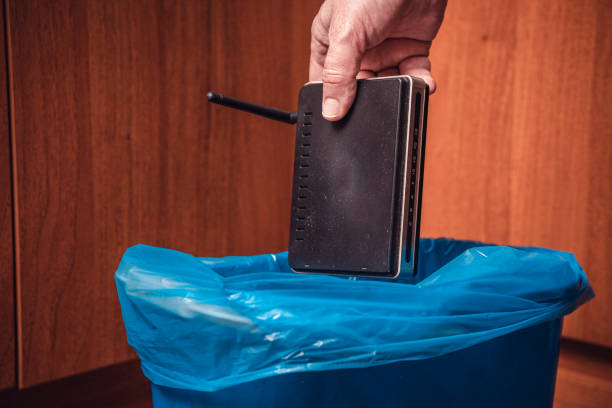Introduction
In today’s digital age, a reliable Wi-Fi connection is essential for both work and leisure. However, many people experience frustration due to slow internet speeds. Fortunately, in most cases, the issue isn’t with the service provider but rather with the setup and maintenance of the Wi-Fi network itself. For your convenience, in this article, we will explore eight common Wi-Fi mistakes that may be slowing down your Wi-Fi and provide actionable tips to rectify them. Let’s start reading.
Mistake 1: Poor Router Placement
Your router’s placement plays an important role in the quality and speed of your Wi-Fi connection. That is why placing it in a corner or behind furniture can obstruct the signal and lead to dead zones in your home or office. Additionally, positioning the router near electronic appliances or dense walls can cause interference, further degrading the signal quality.
Solution: To optimize your Wi-Fi coverage, place your router in a central location, preferably elevated and away from obstructions. This allows the signal to propagate evenly throughout your space, minimizing dead zones and improving overall connectivity.
Mistake 2: Overloading the Network
Moreover, overloading your Wi-Fi network with too many connected devices can strain its capacity and slow down internet speeds for everyone. Each device connected to the network consumes bandwidth, and if the router’s capacity is exceeded, it can lead to sluggish performance and dropped connections.
Solution: To alleviate network congestion, prioritize essential devices and limit the number of simultaneous connections. Consider upgrading to a higher bandwidth plan or investing in a dual-band router that can accommodate more devices without sacrificing speed.
Mistake 3: Outdated Router Firmware
Router manufacturers regularly release firmware updates to address security vulnerabilities, improve performance, and add new features. However, many users neglect to update their router’s firmware, leaving their network susceptible to security breaches and performance issues.
Solution: To get optimal performance and security, regularly check for firmware updates through your router’s administration panel and install them as soon as they become available. This simple yet settling step can significantly enhance your Wi-Fi experience and protect your network from cyber threats.
Mistake 4: Interference from Other Devices
Furthermore, electronic devices such as microwaves, cordless phones, and Bluetooth speakers emit radio frequencies that can interfere with Wi-Fi signals, leading to signal degradation and reduced speeds. The risk of interference is even higher in densely populated areas or crowded environments.
Solution: To minimize interference, keep Wi-Fi routers away from other electronic devices and switch to channels with less congestion. Additionally, consider upgrading to routers equipped with beamforming technology, which focuses signals directly towards connected devices, reducing interference and improving performance.
Mistake 5: Using Outdated Hardware
Wi-Fi technology is evolving rapidly, with newer standards offering faster speeds and greater reliability than their predecessors. So, using outdated hardware, such as routers or network adapters that support older Wi-Fi standards, can limit your connection speeds and hinder your overall internet experience.
Solution: To maximize your Wi-Fi performance, invest in modern hardware that supports the latest Wi-Fi standards, such as Wi-Fi 6 (802.11ax). While upgrading may require upfront investment, the long-term benefits in terms of speed, reliability, and security make it a worthwhile endeavor.

Mistake 6: Neglecting Router Maintenance
Routers, like any electronic device, require regular maintenance to ensure optimal performance and reliability. Dust buildup, overheating, and hardware malfunctions can all affect your router’s ability to deliver fast and stable Wi-Fi connections.
Solution: To maintain your router’s performance, clean it regularly, ensure proper ventilation, and check for any signs of wear or damage. Consider investing in a router with robust build quality and advanced cooling features to prolong its lifespan and minimize the risk of hardware failures.
Mistake 7: Ignoring Software Updates
In addition to router firmware updates, it’s essential to keep your connected devices’ operating systems and applications up to date. Software updates often include patches for security vulnerabilities, bug fixes, and performance optimizations that can enhance your overall Wi-Fi experience.
Solution: Make it a habit to regularly update your devices’ software and enable automatic updates whenever possible. This proactive approach not only improves security but also ensures compatibility with the latest Wi-Fi standards and technologies.
Mistake 8: Lack of Security Measures
Failing to secure your Wi-Fi network leaves it vulnerable to unauthorized access, data breaches, and malicious attacks. Without proper security measures in place, hackers can intercept sensitive information, compromise your privacy, and exploit your network for nefarious purposes.
Solution: To safeguard your Wi-Fi network, enable WPA3 encryption, create strong and unique passwords, and disable remote management features. Additionally, consider implementing network segmentation, firewalls, and intrusion detection systems to fortify your defenses against cyber threats.
| Call 866-861-4084 for Internet Deals |
Tips for Faster Wi-Fi
Upgrade Your Router: Invest in a high-quality router that supports the latest Wi-Fi standards for faster speeds and better coverage.
Optimize Router Placement: Place your router in a central location, elevated and away from obstructions, to ensure even coverage throughout your space.
Use Wi-Fi Extenders or Mesh Networks: Extend your Wi-Fi coverage by using range extenders or mesh networks to eliminate dead zones and improve connectivity in larger spaces.
Limit Concurrent Connections: Avoid overloading your network by limiting the number of devices connected simultaneously. Prioritize essential devices for optimal performance.
Opt for Dual-Band or Tri-Band Routers: Dual-band or tri-band routers offer multiple frequency bands, allowing you to allocate devices to different bands for smoother performance and reduced interference.
Update Router Firmware Regularly: Keep your router’s firmware up to date to ensure optimal performance, security, and compatibility with the latest technologies.
Enable Quality of Service (QoS): Prioritize network traffic by enabling QoS settings to ensure that critical applications receive sufficient bandwidth for smooth operation.
Monitor Bandwidth Usage: Keep track of your network activity and bandwidth usage to identify any unusual patterns or sources of congestion.
Consider Wi-Fi 6 (802.11ax) Technology: Upgrade to Wi-Fi 6 compatible devices and routers for faster speeds, improved efficiency, and better performance in dense environments.
Secure Your Wi-Fi Network: Protect your Wi-Fi network with strong encryption (e.g., WPA3), unique passwords, and firewall settings to prevent unauthorized access and potential security breaches.

Conclusion
That’s a wrap. By avoiding these common Wi-Fi mistakes and implementing the recommended solutions, you can significantly improve the speed, reliability, and security of your Wi-Fi network. Whether you use Wi-Fi for work, entertainment, or staying connected with friends and family, a fast and stable connection is essential for a seamless online experience.
FAQs
How do I know if my router placement is poor?
Signs of poor router placement include dead zones, weak signals, and frequent disconnections. You can use Wi-Fi analyzer apps to assess signal strength and identify optimal placement locations.
What should I do if my Wi-Fi network is overloaded?
To alleviate network congestion, prioritize essential devices, limit the number of simultaneous connections, and consider upgrading to a higher bandwidth plan or a dual-band router.
How often should I update my router firmware?
It’s recommended to check for firmware updates regularly and install them as soon as they become available. This helps ensure optimal performance, security, and compatibility with the latest technologies.
Can using outdated hardware really affect my Wi-Fi speed?
Yes, using outdated hardware, such as routers or network adapters that support older Wi-Fi standards, can limit your connection speeds and hinder your overall internet experience.
What are the essential security measures to protect my Wi-Fi network?
Essential security measures include enabling WPA3 encryption, using strong and unique passwords, disabling remote management features, implementing network segmentation, and regularly updating software and firmware.

Meet Jennifer Harper, a wordsmith extraordinaire who has been shaping the digital landscape with her creative prowess for the past two years. Not just a content writer; she is a storyteller who brings the content to life. Her passion for internet trends, memes, and the ever-evolving world of entertainment is evident in every piece she creates. Jennifer doesn’t just follow trends; she sets them.